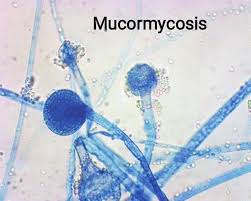
New Hope in Mucormycosis Treatment: AIIMS Researchers Explore Lactoferrin's Potential
Mucormycosis, also known as black fungus, is a severe fungal infection with a high mortality rate, ranging from 30% to over 80%, particularly when diagnosis is delayed or in patients with severe underlying health conditions. This infection can affect the sinuses, brain, lungs, gastrointestinal tract, and skin.
Before the COVID-19 pandemic, mucormycosis was relatively uncommon and mostly seen in individuals with risk factors like uncontrolled diabetes, immunocompromised states, such as organ transplant recipients, cancer patients undergoing chemotherapy, and those with severe burns. However, the pandemic saw a surge in mucormycosis cases, linked to factors such as inappropriate steroid use, diabetes induced by COVID-19, and compromised immune systems.
Current treatment options for mucormycosis involve aggressive surgical intervention to remove infected tissue, combined with antifungal medications like amphotericin B and management of underlying diseases. Despite these treatments, the high mortality rates and limited options highlight the need for alternative therapeutic strategies.
Researchers from the Department of Biophysics and the Department of Microbiology at AIIMS, New Delhi, have discovered the potential of a natural protein called lactoferrin in treating mucormycosis. This protein, when used in combination with existing antifungals, shows promising results. The research team, including Prof. Sujata Sharma, Dr. Gagandeep Singh, Prof. Immaculata Xess, Dr. Pradeep Sharma, and Prof. Tej P. Singh, demonstrated that lactoferrin and its peptides inhibit the deadly fungi when combined with amphotericin B, the first-line treatment for mucormycosis. Lactoferrin was isolated and purified from colostrum, the first milk produced by mothers after childbirth.
Lactoferrin works through several mechanisms. It binds tightly to iron, depriving the fungi of this essential nutrient needed for growth and virulence. It can directly interact with fungal cell membranes, disrupting their integrity and leading to cell death. Additionally, lactoferrin has immunomodulatory properties, enhancing the activity of immune cells like macrophages and neutrophils, which are crucial in fighting fungal infections. It also disrupts biofilms, protective matrices that fungi form, making them more susceptible to immune attack and antimicrobial treatments. Moreover, lactoferrin has anti-inflammatory properties that help reduce inflammation associated with fungal infections.
The researchers described lactoferrin as a "superhero guardian" that helps protect the body from harmful invaders like bacteria and viruses. They highlighted its potential in treating mucormycosis, noting its abundance in bodily secretions, minimal risk of side effects, and sustainability as a natural molecule. With multiple mechanisms of action, lactoferrin makes it harder for fungi to develop resistance. The team is currently testing lactoferrin in animals and working on further development as a potential therapeutic molecule for mucormycosis.
This discovery offers new hope in the fight against mucormycosis, potentially paving the way for more effective treatments and better outcomes for patients affected by this serious infection.